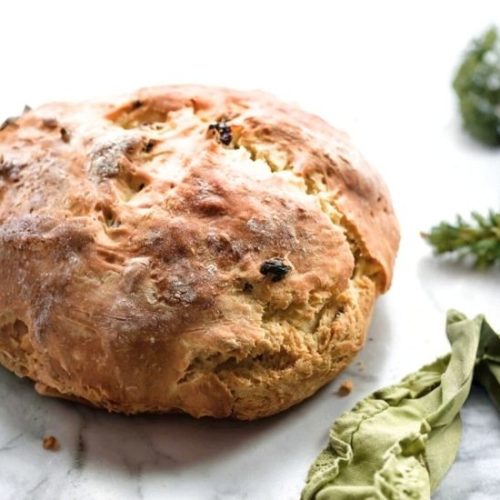
Irish Soda Bread
A quick, no-yeast Irish soda bread with a crusty exterior and tender crumb, traditionally leavened with baking soda and buttermilk. Perfect for beginners and seasoned bakers alike, with optional raisins for sweetness. Ideal for breakfast, snacking, or as a hearty accompaniment to meals.
Equipment
- 1 large mixing bowl
- 1 Whisk
- 1 pastry cutter (or fork/fingers for butter cutting)
- 1 sharp knife or bread lame for scoring
- 1 baking vessel (cast iron skillet, baking sheet with parchment/silicone mat, cake pan, pie dish, or Dutch oven)
- 1 instant-read thermometer (optional but recommended)
Ingredients
- 1 ¾ cups 420 ml cold buttermilk*
- 1 large egg optional, see notes
- 4 ¼ cups 531 g all-purpose flour, plus extra for dusting
- 3 tablespoons 38 g granulated sugar
- 1 teaspoon baking soda
- 1 teaspoon fine salt
- 5 tablespoons 71 g unsalted butter, very cold and cut into small cubes
- 1 cup 150 g raisins (optional)
Instructions
- Prepare Oven and Baking Vessel: Preheat your oven to 400°F (204°C). Choose your baking method: line a baking sheet with parchment paper or a silicone mat, or lightly grease a 10–12 inch cast iron skillet, a 9–10 inch cake pan, pie dish, or a large Dutch oven (if using, bake uncovered). Avoid loaf pans to ensure even baking and a nice flat shape.
- Mix Wet Ingredients: In a medium bowl, whisk together the cold buttermilk and the egg until fully combined. Set this mixture aside while you prepare the dry ingredients.
- Combine Dry Ingredients and Incorporate Butter: In a large mixing bowl, sift together the flour, sugar, baking soda, and salt. Add the cold butter cubes to the flour mixture. Using a pastry cutter, two forks, or your fingertips, work the butter into the flour until the texture resembles coarse crumbs roughly the size of peas.
- Add Raisins and Blend Wet Ingredients: If using, stir the raisins into the flour and butter mixture. Pour the buttermilk and egg mixture into the dry ingredients. Using a sturdy spoon or your hands, gently fold the ingredients together until the dough just begins to come together and becomes too stiff to stir easily.
- Knead Dough Gently: Transfer the dough to a lightly floured surface. Sprinkle a little flour on your hands and knead the dough briefly—about 30 seconds—just until all the flour is moistened and a cohesive ball forms. If the dough feels too sticky, dust with a bit more flour, but be careful not to overdo it.
- Shape and Score Dough: Place the dough ball into your prepared baking vessel. Using a very sharp knife or bread lame, score an “X” shape about ½ inch deep into the top of the dough. This scoring allows steam to escape and helps the bread bake evenly.
- Bake Until Golden and Done: Bake in the preheated oven for 45 to 55 minutes, or until the bread has a golden-brown crust and sounds hollow when tapped on the bottom. To be precise, use an instant-read thermometer; the internal temperature should reach 195°F (90°C). If the top browns too quickly, tent the bread loosely with aluminum foil.
- Cool and Serve: Remove the bread from the oven and allow it to cool for about 10 minutes before transferring to a wire rack. Serve warm, at room temperature, or toasted with your favorite spreads.
Notes
- Buttermilk Substitute: If you don’t have buttermilk, combine 1 tablespoon of white vinegar or lemon juice with enough cold whole or 2% milk to make 1 ¾ cups. Stir and let it sit for 5 minutes before using.
- Egg Optionality: The egg enriches the dough and adds slight density but can be omitted for a lighter bread with no other changes needed.
- Butter Temperature: Use very cold butter, even partially frozen, to keep the dough from becoming sticky and to ensure a tender crumb with a flaky texture.
- Baking Vessel Choice: This bread bakes best as a round, flatter loaf rather than in a traditional loaf pan to allow even cooking throughout.
- Storage: Store leftover bread wrapped tightly in foil at room temperature for up to 2 days or refrigerate for up to 1 week. It also freezes well, either whole or sliced, for up to 3 months.
- Smaller Loaves: To make multiple smaller loaves, divide the dough accordingly. Adjust baking time based on size and always check with a thermometer to confirm doneness.